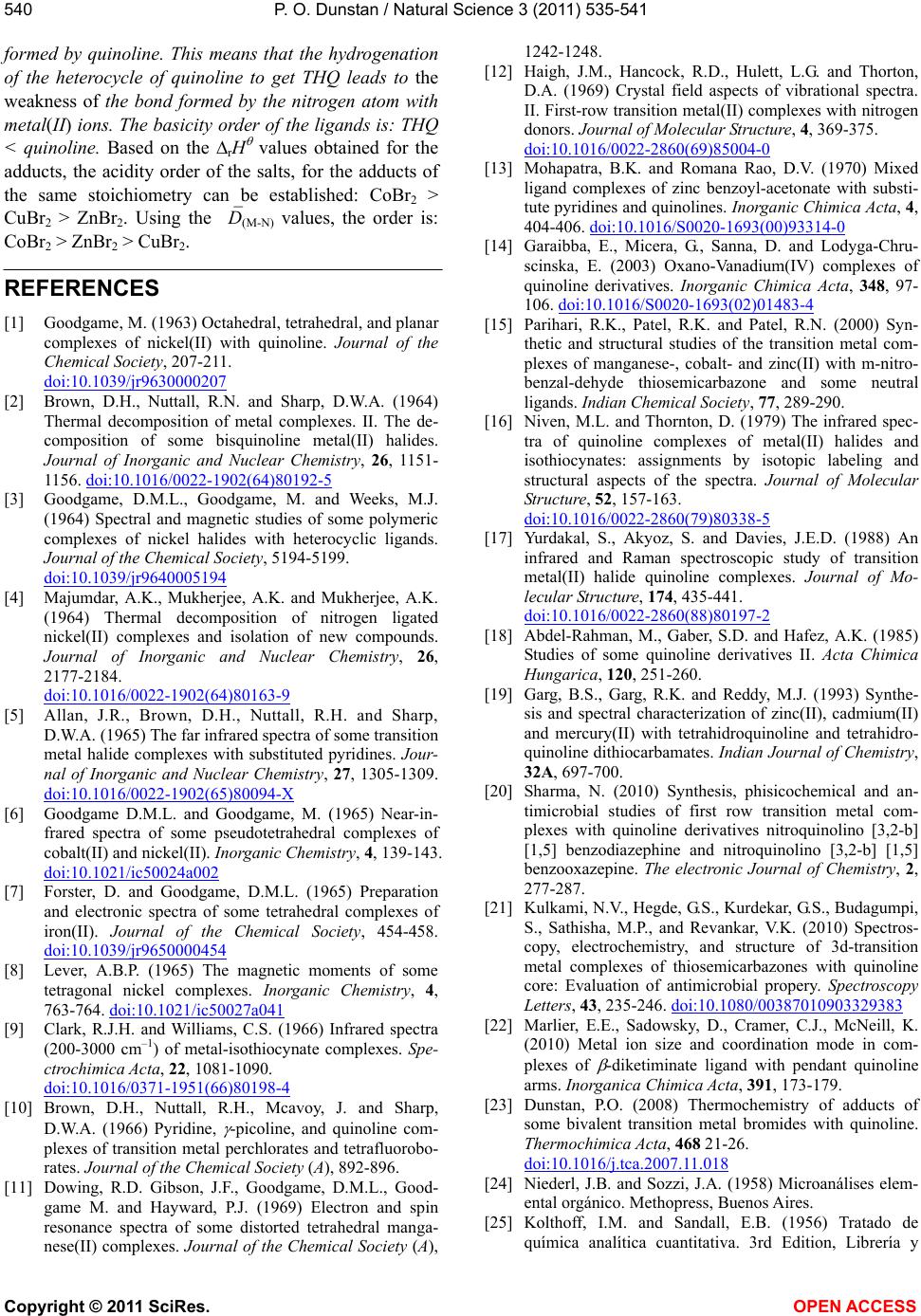
P. O. Dunstan / Natural Science 3 (2011) 535-541
Copyright © 2011 SciRes. OPEN ACCESS
540
formed by quinoline. This means that the hydrogenation
of the heterocycle of quinoline to get THQ leads to the
weakness of the bond formed by the nitrogen atom with
metal(II) ions. The basicity order of the ligands is: THQ
< quinoline. Based on the rH
values obtained for the
adducts, the acidity order of the salts, for the adducts of
the same stoichiometry can be established: CoBr2 >
CuBr2 > ZnBr2. Using the
D(M-N) values, the order is:
CoBr2 > ZnBr2 > CuBr2.
REFERENCES
[1] Goodgame, M. (1963) Octahedral, tetrahedral, and planar
complexes of nickel(II) with quinoline. Journal of the
Chemical Society, 207-211.
doi:10.1039/jr9630000207
[2] Brown, D.H., Nuttall, R.N. and Sharp, D.W.A. (1964)
Thermal decomposition of metal complexes. II. The de-
composition of some bisquinoline metal(II) halides.
Journal of Inorganic and Nuclear Chemistry, 26, 1151-
1156. doi:10.1016/0022-1902(64)80192-5
[3] Goodgame, D.M.L., Goodgame, M. and Weeks, M.J.
(1964) Spectral and magnetic studies of some polymeric
complexes of nickel halides with heterocyclic ligands.
Journal of the Chemical Society, 5194-5199.
doi:10.1039/jr9640005194
[4] Majumdar, A.K., Mukherjee, A.K. and Mukherjee, A.K.
(1964) Thermal decomposition of nitrogen ligated
nickel(II) complexes and isolation of new compounds.
Journal of Inorganic and Nuclear Chemistry, 26,
2177-2184.
doi:10.1016/0022-1902(64)80163-9
[5] Allan, J.R., Brown, D.H., Nuttall, R.H. and Sharp,
D.W.A. (1965) The far infrared spectra of some transition
metal halide complexes with substituted pyridines. Jour-
nal of Inorganic and Nuclear Chemistry, 27, 1305-1309.
doi:10.1016/0022-1902(65)80094-X
[6] Goodgame D.M.L. and Goodgame, M. (1965) Near-in-
frared spectra of some pseudotetrahedral complexes of
cobalt(II) and nickel(II). Inorganic Chemistry, 4, 139-143.
doi:10.1021/ic50024a002
[7] Forster, D. and Goodgame, D.M.L. (1965) Preparation
and electronic spectra of some tetrahedral complexes of
iron(II). Journal of the Chemical Society, 454-458.
doi:10.1039/jr9650000454
[8] Lever, A.B.P. (1965) The magnetic moments of some
tetragonal nickel complexes. Inorganic Chemistry, 4,
763-764. doi:10.1021/ic50027a041
[9] Clark, R.J.H. and Williams, C.S. (1966) Infrared spectra
(200-3000 cm–1) of metal-isothiocynate complexes. Spe-
ctrochimica Acta, 22, 1081-1090.
doi:10.1016/0371-1951(66)80198-4
[10] Brown, D.H., Nuttall, R.H., Mcavoy, J. and Sharp,
D.W.A. (1966) Pyridine,
-picoline, and quinoline com-
plexes of transition metal perchlorates and tetrafluorobo-
rates. Journal of the Chemical Society (A), 892-896.
[11] Dowing, R.D. Gibson, J.F., Goodgame, D.M.L., Good-
game M. and Hayward, P.J. (1969) Electron and spin
resonance spectra of some distorted tetrahedral manga-
nese(II) complexes. Journal of the Chemical Society (A),
1242-1248.
[12] Haigh, J.M., Hancock, R.D., Hulett, L.G. and Thorton,
D.A. (1969) Crystal field aspects of vibrational spectra.
II. First-row transition metal(II) complexes with nitrogen
donors. Journal of Molecular Structure, 4, 369-375.
doi:10.1016/0022-2860(69)85004-0
[13] Mohapatra, B.K. and Romana Rao, D.V. (1970) Mixed
ligand complexes of zinc benzoyl-acetonate with substi-
tute pyridines and quinolines. Inorganic Chimica Acta, 4,
404-406. doi:10.1016/S0020-1693(00)93314-0
[14] Garaibba, E., Micera, G., Sanna, D. and Lodyga-Chru-
scinska, E. (2003) Oxano-Vanadium(IV) complexes of
quinoline derivatives. Inorganic Chimica Acta, 348, 97-
106. doi:10.1016/S0020-1693(02)01483-4
[15] Parihari, R.K., Patel, R.K. and Patel, R.N. (2000) Syn-
thetic and structural studies of the transition metal com-
plexes of manganese-, cobalt- and zinc(II) with m-nitro-
benzal-dehyde thiosemicarbazone and some neutral
ligands. Indian Chemical Society, 77, 289-290.
[16] Niven, M.L. and Thornton, D. (1979) The infrared spec-
tra of quinoline complexes of metal(II) halides and
isothiocynates: assignments by isotopic labeling and
structural aspects of the spectra. Journal of Molecular
Structure, 52, 157-163.
doi:10.1016/0022-2860(79)80338-5
[17] Yurdakal, S., Akyoz, S. and Davies, J.E.D. (1988) An
infrared and Raman spectroscopic study of transition
metal(II) halide quinoline complexes. Journal of Mo-
lecular Structure, 174, 435-441.
doi:10.1016/0022-2860(88)80197-2
[18] Abdel-Rahman, M., Gaber, S.D. and Hafez, A.K. (1985)
Studies of some quinoline derivatives II. Acta Chimica
Hungarica, 120, 251-260.
[19] Garg, B.S., Garg, R.K. and Reddy, M.J. (1993) Synthe-
sis and spectral characterization of zinc(II), cadmium(II)
and mercury(II) with tetrahidroquinoline and tetrahidro-
quinoline dithiocarbamates. Indian Journal of Chemistry,
32A, 697-700.
[20] Sharma, N. (2010) Synthesis, phisicochemical and an-
timicrobial studies of first row transition metal com-
plexes with quinoline derivatives nitroquinolino [3,2-b]
[1,5] benzodiazephine and nitroquinolino [3,2-b] [1,5]
benzooxazepine. The electronic Journal of Chemistry, 2,
277-287.
[21] Kulkami, N.V., Hegde, G.S., Kurdekar, G.S., Budagumpi,
S., Sathisha, M.P., and Revankar, V.K. (2010) Spectros-
copy, electrochemistry, and structure of 3d-transition
metal complexes of thiosemicarbazones with quinoline
core: Evaluation of antimicrobial propery. Spectroscopy
Letters, 43, 235-246. doi:10.1080/00387010903329383
[22] Marlier, E.E., Sadowsky, D., Cramer, C.J., McNeill, K.
(2010) Metal ion size and coordination mode in com-
plexes of
-diketiminate ligand with pendant quinoline
arms. Inorganica Chimica Acta, 391, 173-179.
[23] Dunstan, P.O. (2008) Thermochemistry of adducts of
some bivalent transition metal bromides with quinoline.
Thermochimica Acta, 468 21-26.
doi:10.1016/j.tca.2007.11.018
[24] Niederl, J.B. and Sozzi, J.A. (1958) Microanálises elem-
ental orgánico. Methopress, Buenos Aires.
[25] Kolthoff, I.M. and Sandall, E.B. (1956) Tratado de
química analítica cuantitativa. 3rd Edition, Librería y